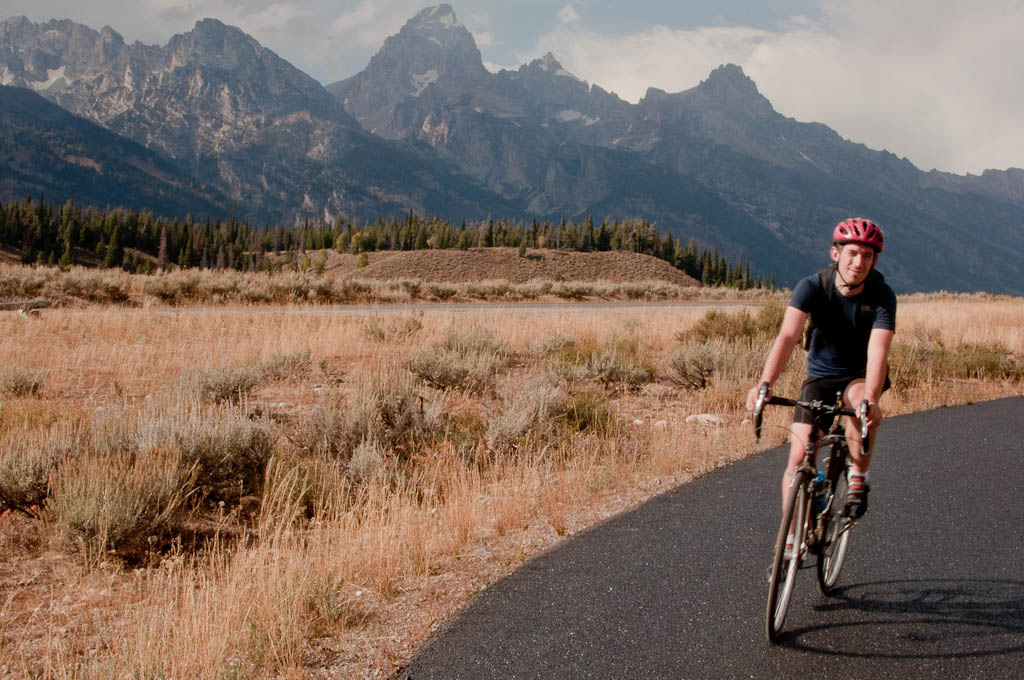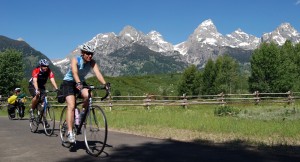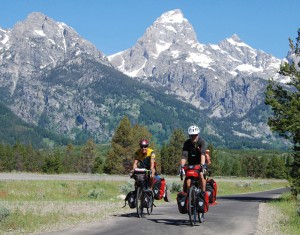
Ben Martin rides along a multipurpose pathway in Grand Teton National Park in October 2011. Martin has concerns about a proposed federal law that would require bikers to use pathways instead of adjacent roads. (Photo ©2011 Breeanne Martin)
By Ruffin Prevost
A paved multipurpose pathway that stretches eight miles through part of Grand Teton National Park has received high marks from bicyclists since it opened in 2009, but some of those same bikers worry that a proposed federal law may force them off the adjacent highway and require them to use only the pathway.
The situation is not unique to Grand Teton. A pending federal transportation spending bill, dubbed the “mandatory sidepath law” by opponents, would require cyclists to use paved bike paths on any federal lands where the path is within 100 yards of a federal road with a speed limit of 30 mph or higher.
The so-called “bicycle safety” provision written into S. 1813 has drawn fire from bicycle advocacy groups that see it as a bad precedent likely to erode bikers’ rights and their access to public roads. Some cyclist groups are focusing on Grand Teton and other national parks as high-profile examples of places where sharing the road could become a thing of the past.
“I think we’re intelligent human beings, and we should have the right to ride either the road or the path,” said David Hunger, a bicyclist and owner of Teton Mountain Bike Tours.

A multipurpose pathway in Grand Teton National Park has averaged more than 19,000 trips each year since it opened in May 2009. Some cyclists are opposed to a proposed law that would require them to use the pathway instead of adjacent roads. (NPS Photo)
Hunger, whose company rents bikes and offers bicycling tours of Grand Teton and Yellowstone national parks, said he understood the idea behind promoting the relative safety of the adjacent path. But it should be an individual choice, not a government mandate, he said.
Road riders often go on group rides with several cyclists traveling in a long line together at high speeds, an option that would be unsafe and impractical on a path with pedestrians and slower recreational bikers, he said.
“I would love to see more people on the bike path, it’s great. But you have to give them the option” of using the road or the path, Hunger said.
Ben Martin, a software engineer from Utah, said the multipurpose pathway from Moose to South Jenny Lake was “awesome” for leisure cyclists, but not ideal for the fastest riders who are out for a challenging ride.
“Many leisure-minded cyclists and pedestrians often take up the entire width of the path or ride on the wrong side entirely, turning what would be a fast, consistent ride into a session of dodging and weaving,” said Martin, who biked though Grand Teton with his wife in October.
Martin averages 24 mph on road rides and said he has found most motorists in national parks to be courteous and attentive.
“Regardless of whether the legislation passes, the path would be much nicer to ride on in the busy season were lanes put in and signs posted to remind people that the path is not just like a sidewalk,” he said. “There are still rules, you still need to pay attention and courtesy should still be given from all sides.”
Since it opened in May 2009, the multipurpose path has averaged more than 19,000 annual trips, mostly by bicyclists, said Grand Teton spokeswoman Jackie Skaggs.

Bicyclists ride along a multipurpose pathway in Grand Teton National Park. A National Park Service transportation plan calls for 42 miles of pathways within the park. (NPS Photo)
“It has seen three summer seasons of use and has been wholeheartedly embraced by visitors and locals for the opportunity to separate themselves from traffic” on nearby Teton Park Road, Skaggs said.
Usage studies have shown that traffic on the path is about 96 percent bicyclists with roughly 3 percent pedestrians and about 1 percent Rollerbladers.
The National Park Service doesn’t have a position on the pending legislation and its bicycle safety provision, Skaggs said, and the agency would implement whatever policy is mandated by Congress.
A Park Service transportation plan for Grand Teton calls for a total of 42 miles of pathways through the park, with sections built in phases as funding allows, Skaggs said.
A new six-mile section will open this summer, connecting the existing pathway at Moose with a completed six-mile section leading north out of Jackson. That segment was built by the Jackson Hole Community Pathways System, a joint effort by the town of Jackson and Teton County. The new segment will complete a continuous 20-mile section between Jackson and South Jenny Lake.
Bike paths are propagating throughout the Jackson area — and not just within park boundaries — largely as a way to offer bikers, walkers and others a separate commuter or recreational route along scenic and busy highways.
Safety and separation from vehicle traffic were driving factors behind the development of Grand Teton’s multipurpose pathway, Skaggs said.
National Park Service rules and recommendations for bicyclists: Bicyclists must obey all traffic signs and yield to motorized vehicles. Bicycles are allowed on paved and unpaved roads open to motorized vehicles, unless otherwise posted. On the road, between sunset and sunrise, bicycles must have a white light or reflector on front, and a red light or reflector on back. Bicycles are allowed on the multi-use pathway from dawn to dusk only. Bicycles are not allowed on trails or in backcountry areas. Riding bicycles two abreast on paved roads or on the pathway is prohibited. Notify othes before passing. Yield to slower users. Use personal audio devices with caution. Helmets and bright-colored clothes are recommended due to heavy traffic. Pets are not allowed on the multi-use pathway.
Two different vehicle-biker collisions resulting in cyclist fatalities about a decade ago drove home the potential dangers of riding on sections of park roads that have no bike lanes and narrow or no shoulders. Another incident this year left a cyclist injured after being struck by a delivery truck’s side mirror, Skaggs said.
Bicycle advocates often push for development of bike lanes, separate paths and other public trails open to cyclists, but some worry that any move to ban cyclists from highways is a step in the wrong direction.
The proposed legislation would “take back a right that cyclists have fought for a long time to have,” and could “set a bad precedent that would give other lawmakers that same idea,” said Meghan Cahill, spokeswoman for the League of American Bicyclists, a cyclists’ lobby in Washington, D.C.
“Not every bicyclist is the same,” Cahill said. “Some just starting out might feel more comfortable on a multi-use trail or path. But a lot of road cyclists who are traveling at high speeds might prefer the road.”
“They have the right to the road, and that’s what they’ve been working for,” she said.
More than 12,000 people have signed an online petition opposing the mandatory sidepath provision. The League is seeking support from Sen. John Barrasso, R-Wyo., and other senators in Western states who might back their effort to remove the provision, Cahill said.
“Senator Barrasso is aware of this provision in the transportation bill and is reviewing it,” said Emily Lawrimore, spokeswoman for Barrasso. “He believes we need to work to find an appropriate balance between safety and access.”
The Senate Environment and Public Works Committee has approved the current draft transportation funding bill. A final decision on the measure could come by March, when current highway funding provisions expire.
Contact Ruffin Prevost at 307-213-9818 or ruffin@yellowstonegate.com.
